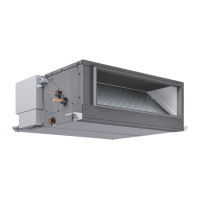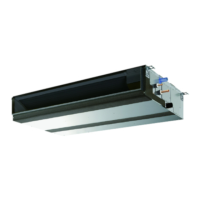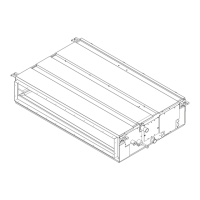8
GB
6.Refrigerantpipeanddrainpipespecications
Toavoid dew drops, provide sufcient antisweating and insulating work to the
refrigerant and drain pipes.
When using commercially available refrigerant pipes, be sure to wind commer-
cially available insulating material (with a heat-resisting temperature of more
than100°C[212°F]andthicknessgivenbelow)ontobothliquidandgaspipes.
Be also sure to wind commercially available insulating material (with a form
polyethylene’sspecicgravityof0.03andthicknessgivenbelow)ontoallpipes
which pass through rooms.
1
Selectthethicknessofinsulatingmaterialbypipesize.
Pipesize Insulatingmaterial’sthickness
6.4 mm to 25.4 mm [1/4 in to 1 in] More than 10 mm [7/16 in]
28.6 mm to 38.1 mm [1-1/8 in to 1-1/2 in] More than 15 mm [5/8 in]
2
If the unit is used on the highest story of a building and under conditions of
hightemperatureandhumidity,itisnecessarytousepipesizeandinsulating
material’sthicknessmorethanthosegiveninthetableabove.
3
Iftherearecustomer’sspecications,simplyfollowthem.
6.1. Refrigerantpipespecications
Refrigerantpipesizes
R410A
Liquid pipe Gas pipe
Pipesize Pipesize
P15·18 O.D. ø6.35 mm (1/4") O.D. ø12.7 mm (1/2")
P24·27·30·36·48·54 O.D. ø9.52 mm (3/8") O.D. ø15.88 mm (5/8")
6.2. Refrigerantpipe,drainpipeandlling
port
[Fig. 6.2.1] (P.2)
A
Air inlet
B
Refrigerant piping (liquid)
C
Refrigerant piping (gas)
D
Control box
E
Drain outlet
F
Air outlet
6.3. Requestforrefrigerantpipingconnec-
tion
Connecting refrigerant piping
• Afterconnectingrefrigerantpiping,insulatethejoints(aredjoints)withther-
mal insulation tubing as shown below.
[Fig.6.3.1](P.3)
A
Thermal insulation tubing
1
B
Caution:
Pulloutthethermalinsulationontherefrigerantpipingatthesite,brazethepiping,
and replace the insulation in its original position.
Takecaretoensurethatcondensationdoesnotformonexposedcopperpiping.
C
Refrigerant piping (liquid)
D
Refrigerant piping (gas)
E
Main body
F
Thermal insulation tubing
2
G
Site refrigerant piping
H
Ensure that there are no gaps between the insulation and the main body.
I
Thermal insulation tubing (small) (accessory)
1
J
Tie band (large) (accessory)
4
K
Ensure that there is no gap here. Place join upwards.
L
Thermal insulation tubing (large) (accessory)
2
M
Cut
N
Releasegasbeforeremovingthebrazing.
O
Thermal insulation
P
Pull
Q
Pipe end
R
Wrap with damp cloth
S
Return to original position
T
Ensure that there is no gap here.
Caution:
Beforeremovingthebrazing,cutofftheendofthepipetoreleaseanygas.
Ifthegasisnotreleased,thepipemayyoff.
1. Pulloutthethermalinsulationonthesiterefrigerantpiping,brazetheunit
piping, and replace the insulation in its original position.
* Beforebrazingtherefrigerantpiping,alwayswrapthepipingonthemain
body,andthethermalinsulationpiping,withdampclothstoprevent
heatshrinkageandburningthethermalinsulationtubing.Takecareto
ensurethattheamedoesnotcomeintocontactwiththemainbodyitself.
Refrigerantamountadjustment
Refer to the installation manual for the outdoor unit for details on adjusting the
amount of refrigerant.
7. Connecting refrigerant pipes and drain pipes
7.1. Refrigerantpipingwork
This piping work must be done in accordance with the installation manuals for
both outdoor unit and BC controller (simultaneous cooling and heating series R2).
• Series R2 is designed to operate in a system that the refrigerant pipe from an
outdoor unit is received by BC controller and branches at the BC controller to
connect between indoor units.
• For constraints on pipe length and allowable difference of elevation, refer to
the outdoor unit manual.
• Themethodofpipeconnectionisbrazingconnection.
Cautions On Refrigerant Piping
u
Besuretousenon-oxidativebrazingforbrazingtoensurethatnofor-
eign matter or moisture enter into the pipe.
u
Besuretoapplyrefrigerating machine oil over the flare connection
seatingsurfaceandtightentheconnectionusingadoublespanner.
u
Provideametalbracetosupporttherefrigerantpipesothatnoloadis
impartedtothe indoorunitendpipe.This metalbraceshouldbepro-
vided50cmawayfromtheindoorunit’sareconnection.
Warning:
Wheninstallingandmovingtheunit,donotchargeitwithrefrigerantother
thantherefrigerantspeciedontheunit.
- Mixing of a different refrigerant, air, etc. may cause the refrigerant cycle to
malfunction and result in severe damage.
Caution:
• Use refrigerant piping made of C1220 (Cu-DHP) phosphorus deoxidized
copperasspeciedin theJISH3300“Copperand copper alloyseam-
lesspipesand tubes”.Inaddition,besure that theinnerandouter
surfacesofthepipesarecleanandfreeofhazardoussulphur,oxides,
dust/dirt,shavingparticles,oils,moisture,oranyothercontaminant.
• Never use existing refrigerant piping.
- The large amount of chlorine in conventional refrigerant and refrigerator oil
in the existing piping will cause the new refrigerant to deteriorate.
• Storethepipingtobeusedduringinstallationindoorsandkeepboth
endsofthepipingsealeduntiljustbeforebrazing.
- If dust, dirt, or water gets into the refrigerant cycle, the oil will deteriorate
and the compressor may fail.
• Useesteroil,etheroiloralkylbenzene(smallamount)astherefrigera-
toroiltocoataresandangeconnections.(FormodelsusingR410A
or R407C)
- The refrigerant used in the unit is highly hygroscopic and mixes with water
and will degrade the refrigerator oil.

